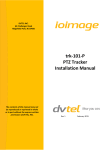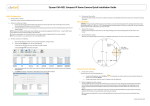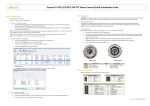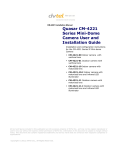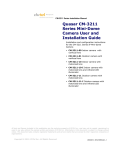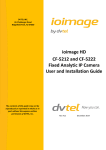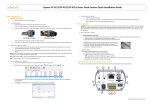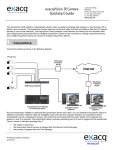Download DVTEL ioimage trk1 Installation manual
Transcript
DVTEL INC. 65 Challenger Road Ridgefield Park, NJ 07660 trk1 Installation Manual The contents of this guide may not be reproduced or reprinted in whole or in part without the express written permission of DVTEL, INC. Ver. A1 April 2013 Document Information Table of Contents 1 Document Information ....................................................................................................iii 2 Introduction.................................................................................................................... 1 2.1 Items Included in the Package ....................................................................................... 2 2.2 Hardware Description .................................................................................................... 2 3 2.2.1 Power Connection Panel............................................................................................. 2 2.2.2 Video Connection Panel.............................................................................................. 3 Installing and Connecting the Unit ................................................................................... 5 3.1 Installing the Unit ........................................................................................................... 5 3.1.1 3.2 Assembling the Unit in a Rack Mount Panel (Optional Accessory) ............................ 6 Connecting the Unit ....................................................................................................... 8 3.2.1 Grounding the Unit ..................................................................................................... 8 3.2.2 Connecting the Unit to the Power Supply .................................................................. 8 3.2.3 Connecting the Unit to the Network .......................................................................... 9 3.2.4 Connecting the Video Source (Camera) to the Unit ................................................. 10 3.2.5 Connecting the Analog Video Output to an Analog Device ...................................... 10 3.2.6 Connecting the Unit to Receive Alarms from External Devices (Alarm Inputs)........ 11 3.2.7 Connecting the Unit to Control an External Device (Using Relay Outputs) .............. 11 3.3 Resetting the Unit ........................................................................................................ 13 3.3.1 Reset Using the Reset Button ................................................................................... 13 3.3.2 Reset by Removing the Power Supply ...................................................................... 13 3.4 Solo Setup .................................................................................................................... 13 Appendix .............................................................................................................................15 A.1. Technical Specifications ............................................................................................... 16 A.2. Connecting Leads to a Spring Clamp Terminal Block ................................................... 18 A.3. Solo Setup Window ...................................................................................................... 19 A.4. Troubleshooting ........................................................................................................... 21 Contacting DVTEL .................................................................................................................24 i trk1 Installation Manual List of Figures Figure 1: trk1 Unit ...................................................................................................................................... 1 Figure 2: trk1 Unit Connectivity ................................................................................................................. 1 Figure 3: trk1 Power Connection Panel ..................................................................................................... 2 Figure 4: trk1 Video Connection Panel ...................................................................................................... 3 Figure 5: trk1 with Nuts Removed ............................................................................................................. 6 Figure 6: Inserting Units into Rack Mount Panel ....................................................................................... 6 Figure 7: Unit Secured to Rack Mount Panel ............................................................................................ 7 Figure 8: Rack Mount Assembly with Eight Units ...................................................................................... 7 Figure 9: Configurator Window ................................................................................................................ 10 Figure 10: Relay Contacts ....................................................................................................................... 12 Figure 11: Spring Clamp Terminal Block ................................................................................................. 18 Figure 12: Connecting a Wire to a Terminal Block .................................................................................. 18 Figure 13: Solo Setup Window ................................................................................................................ 19 ii Document Information 1 Document Information Document Scope and Purpose The purpose of this document is to provide instructions and installation procedures for physically connecting the trk1 encoder. After completing the physical installation, additional setup and configurations are required before video analysis and detection can commence. For information on the unit setup and configuration, refer to the HTML Edition Units User’s Guide. Note: This document is intended for use by technical users who have a basic understanding of CCTV camera/video equipment and LAN/WAN network connections. Warning: Installation must follow safety, standards, and electrical codes as well as the laws that apply where the units are being installed. Proprietary Rights and Non-Disclosure This manual is delivered subject to the following restrictions and conditions: This document contains proprietary information belonging to DVTEL, Inc. This information is supplied solely for the purpose of assisting explicitly the licensee of the DVTEL units. No part of this document contents may be used for any other purpose, disclosed to any third party or reproduced by any means, electronic or mechanical, without the express prior written permission of DVTEL, Inc. Trademarks and Copyrights This manual and its contents herein are owned by DVTEL, Inc. All rights reserved. DVTEL, the DVTEL logo, ioimage, the ioimage logo, ioimage analytics®, ioiware, ioibox, trk1, trk10d, trk100, trk100d, trk-101, trk200, trk4000d, trk8000, ioiware command center, ioiware setup, ioicam mmp100dn, IOI-XTRK-10D, IOI-XTRK-100D, XPVA-10D, XPVA-100D, and sc1dn-A are trademarks of DVTEL, Inc. Products and trademarks mentioned herein are for identification purposes only and may be registered trademarks of their respective companies. DVTEL, Inc. makes no representations whatsoever about any other products or trademarks mentioned in the manual. 2013 © DVTEL, Inc. All rights reserved. iii trk1 Installation Manual Disclaimer Users of DVTEL products accept full responsibility for ensuring the suitability and considering the role of the product detection capabilities and their limitation as they apply to their unique site requirements. DVTEL, Inc. and its agents make no guarantees or warranties to the suitability for the users’ intended use. DVTEL, Inc. accepts no responsibility for improper use or incomplete security and safety measures. Failure in part or in whole of the installer, owner, or user in any way to follow the prescribed procedures or to heed WARNINGS and CAUTIONS shall absolve DVTEL, Inc. and its agents from any resulting liability. Specifications and information in this guide are subject to change without notice. Document Conventions WARNING and CAUTION notes are distributed throughout this document, whenever applicable, to alert you of potentially hazardous situations. These may be hazards associated with a task or a procedure you are carrying out or are about to carry out. The following document conventions are used throughout this manual: A Warning is a precautionary message that indicates a procedure or condition where there are potential hazards of personal injury or death. A Caution is a precautionary message that indicates a procedure or condition where there are potential hazards of permanent damage to the equipment and or loss of data. A Note is useful information to prevent problems, help with successful installation, or to provide additional understanding of the products and installation. A Tip is information and best practices that are useful or provide some benefit for installation and use of ioimage products. General Cautions and Warnings This section contains information that indicates a procedure or condition where there are potential hazards. These may be hazards associated with a task or procedure a user is carrying out or about to carry out. WARNINGS and CAUTIONS are distributed throughout this document, whenever applicable, to alert the user of potentially hazardous situations. SAVE ALL SAFETY AND OPERATING INSTRUCTIONS FOR FUTURE USE. Although the unit is designed and manufactured in compliance with all applicable safety standards, certain hazards are present during the installation of this equipment. To help ensure safety and to help reduce risk of injury or damage, observe the following: iv Document Information Warning: 1. Only qualified trained personnel should service and repair this equipment. 2. Observe local codes and laws and ensure that installation and operation are in accordance with fire, security and safety standards. Electrical Safety Notice and Warnings Warning: 1. Read the installation instructions before you connect the unit to a power source. 2. Electrical safety should always be observed. All electrical connections must be performed by a certified electrician. 3. Use the supplied power supply and protect against static electricity, ground faults and power surges. 4. The unit uses a three-wire power cord to make sure that the product is properly grounded when in use. The plug on this cord will only fit into a grounding-type outlet. This is a safety feature. If the intended power outlet does not support three prongs, one of which is a ground, contact an electrician to install the appropriate outlet. NEVER remove or otherwise attempt to bypass the ground pin of the power cord. Do not operate the unit in the absence of a suitably installed ground conductor. 5. If you use an extension cord with this system, make sure that the total ampere rating on the products plugged into the extension cord does not exceed the extension cord ampere rating. 6. To avoid possible shock hazards or damaging the unit, assure that the positive and negative of the power leads are properly connected to the terminal block connector before plugging it into the unit or turning on the power source. 7. In the following situations, the electric power should be turned off immediately and appropriate repairs, replacements or remedies should be taken if: The power line or plug is damaged, frayed or shows heavy wear. The unit has been physically crushed or deformed. The unit has been exposed to water. The unit has been exposed to, or shows signs of damage from, fire, intense heat, heavy smoke, fumes, or vapors. Electrical connections of the unit become abnormally hot or generate smoke. The unit has been dropped, damaged or shows signs of loose internal parts. The unit does not operate properly. v trk1 Installation Manual Caution: To avoid damage from overheating or unit failure, assure that there is sufficient temperature regulation to support the unit’s requirements. Operating temperature should be kept in the range 0° to 50°C (32° to 122°F), with no more than 95% non-condensing humidity. Minimizing EMI and RFI When wires run for a significant distance in an electromagnetic field, electromagnetic interference (EMI) can occur. Strong EMI (e.g. lightning or radio transmitters) can destroy the units and can pose an electrical hazard by conducting power through lines and into the system. Poor quality or worn wiring can result in radio frequency interference (RFI). To minimize the effects of EMI and RFI, consult your reseller. Site Preparation There are several requirements that should be properly addressed prior to installation at the site. The following specifications are requirements for proper installation and operation of the unit: Ambient Environment Conditions: Avoid positioning the unit near heaters or heating system outputs. Avoid exposure to direct sunlight. Use proper maintenance to ensure that the unit is free from dust, dirt, smoke, particles, chemicals, smoke, water or water condensation, and exposure to EMI. Accessibility: The location used should allow easy access to unit connections and cables. Safety: Cables and electrical cords should be routed in a manner that prevents safety hazards, such as from tripping, wire fraying, overheating, etc. Ensure that nothing rests on the unit’s cables or power cords. Ample Air Circulation: Leave enough space around the unit to allow free air circulation. Cabling Considerations: Units should be placed in locations that are optimal for the type of video cabling used between the unit and the cameras and external devices. Using a cable longer than the manufacturer’s specifications for optimal video signal may result in degradation of color and video parameters. Physical Security: The unit provides threat detection for physical security systems. In order to ensure that the unit cannot be disabled or tampered with, the system should be installed with security measures regarding physical access by trusted and un-trusted parties. Network Security: The unit transmits over IP to security personnel for video surveillance. Proper network security measures should be in place to assure networks remain operating and free from malicious interference. The unit is intended for installation on the backbone of a trusted network. Electrostatic Safeguards: The unit as well as other equipment connected to it (relay outputs, alarm inputs, racks, carpeting, etc) shall be properly grounded to prevent electrostatic discharge. The physical installation of the unit is the first phase of making the unit operational in a security plan. The goal is to physically place the unit, connect it to other devices in the system, and to establish network connectivity. When finished with the physical installation, refer to the HTML Edition Units User’s Guide to complete the second phase of installation, which is the setup and configuration of the unit. vi Introduction 2 Introduction The trk1 is a self-contained video analytic IP encoder that monitors the video input from a camera, providing real-time detection and autonomous tracking capabilities. Operators can define rules, perimeter lines, sterile zones and other criteria for intrusion detection. In addition to its analytic capabilities, the encoder also transforms the input video into a standards-compliant, compressed IP video stream. Figure 1: trk1 Unit The unit analyzes the captured video signal, generates alarms, and notifies operators of the presence of people, vehicles or objects. It can stop and detect events in multiple preset zones. Users can define the events and location in the video of the image that can be detected with user-customizable rules and positioning criteria. The camera simultaneously provides video output in two formats: analog video and compressed digital video over IP. On-screen overlays indicate where the detection has occurred on the video output. Figure 2: trk1 Unit Connectivity This chapter includes the following sections: Items Included in the Package (page 2) Hardware Description (page 2) 1 trk1 Installation Manual 2.1 Items Included in the Package The unit package contains the following items: QTY Description 1 trk1 encoder 1 AC adaptor with power cord 2 Terminal block spring clamp connectors 1 Documentation and utilities CD Related Documentation: HTML Edition Units User’s Guide ioi Product Selection Matrix 2.2 Hardware Description This section describes the connection panels of the unit. 2.2.1 Power Connection Panel The following is a description of the power connection panel of the unit. Figure 3: trk1 Power Connection Panel The power connection panel of the unit includes the following items: 2 Item Description Grounding Terminal For connecting the unit to the protective ground (earth) according to local regulations and codes. For more information, see Grounding the Unit (page 8). POWER Input For powering the unit from a 12VDC power source. Introduction Item Description Ethernet 802.3af PoE Network Port (RJ-45) For connecting the unit to the Ethernet network (10/100 Mbps) and powering the unit via PoE. External Devices Connection Terminal block for the following connections: DRY IN (Alarm Input): Single alarm input connection (a set of two wires) from an external device — for example, a fire sensor, PIR (passive infrared sensor, fence sensor, etc.) with a dry contact output to the terminal block. RELAY (Relay Output): Output signal (opto-isolated) for a single external device, such as an electrical door lock. o NO: Terminal for NORMALLY OPEN configurations o COM: Terminal for COMMON wire configurations for either NC or NO NC: Terminal for NORMALLY CLOSED configurations RS232: Not in use. Ground: Additional ground connection. RS485: Not in use. o Indication Light (LED) Not in use. 2.2.2 Video Connection Panel The following is a description of the video connection panel of the unit. Figure 4: trk1 Video Connection Panel 3 trk1 Installation Manual The video connection panel of the unit includes the following items: Item Description Video In (BNC) Input interface for receiving the surveillance camera analog video signal (source) for analysis and detection. Video Out (BNC) Output interface that provides the PAL or NTSC analog video signal after analysis and includes detection overlays and additional On-Screen Display (OSD) information. Typically connected to analog video equipment such as analog video displays or an analog video recording device or a digital video recorder (DVR). Note: In order to view analog video, analog video out must be enabled in the unit settings (disabled by default). For more information on how to enable the analog video out signal, refer to the HTML Edition Units User’s Guide. Reset Button For resetting the unit to its previous settings. 4 Installing and Connecting the Unit 3 Installing and Connecting the Unit This section describes how to install and connect the unit and includes the following sections: Installing the Unit (page 5) Connecting the Unit (page 8) Resetting the Unit (page 13) Note: After connecting the unit, proceed to configure the unit as described in the HTML Edition Units User’s Guide. 3.1 Installing the Unit The unit can be installed and mounted next to the camera (inside the camera enclosure). Alternatively, the unit can be installed inside an equipment room on a shelf or in a rack using the rack mount panel that is available as an optional accessory. When installing the unit make sure that: It is securely tied down and cannot be easily dislodged Operating temperatures, at all times, are kept between the minimum/maximum allowed Proper ventilation is provided so that the air is free to circulate around the unit The unit is protected from direct weather conditions (for example, sunlight, rain, dust, and so on) Caution: To avoid damage from overheating or unit failure, do not block the vents of the unit, and ensure that there is sufficient temperature regulation to support the unit’s cooling/heating requirements. Ambient operating temperature should be kept in the range 0°C to 50°C (32° to 122°F) ), with no more than 95% non-condensing humidity. 5 trk1 Installation Manual 3.1.1 Assembling the Unit in a Rack Mount Panel (Optional Accessory) Up to 8 units can be mounted on a single rack mount panel. After the units have been assembled in the rack mount panel, the panel can be installed in a standard 19-inch rack. To assemble units in a rack mount panel 1. Remove the nut and washer from each of the two video connectors on the video connection panel of the unit. Figure 5: trk1 with Nuts Removed 2. Attach each unit to the rear side of the rack mount panel by inserting it through the holes as shown in Figure 6. Position each unit so that the Reset button is clearly visible through the Reset hole in the rack mount panel. Figure 6: Inserting Units into Rack Mount Panel 6 Installing and Connecting the Unit 3. Fasten each unit using the nuts and washers removed in step 1, making sure to first place the washer on each video connector before tightening the nut on the video connector. Figure 7: Unit Secured to Rack Mount Panel 4. Repeat steps 1 through 3 for each of the units you want to assemble on the rack mount panel (up to 8 units can be assembled per panel). 5. The following is an example of the rack mount assembly holding eight units. Figure 8: Rack Mount Assembly with Eight Units 6. Attach the rack mount panel to a 19" rack. 7 trk1 Installation Manual 3.2 Connecting the Unit This section describes the procedures for connecting the unit and includes the following sub-sections: Grounding the Unit (page 8) Connecting the Unit to the Power Supply (page 8) Connecting the Unit to the Network (page 9) Connecting the Video Source (Camera) to the Unit (page 10) Connecting the Analog Video Output to an Analog Device (page 10) Connecting the Unit to Receive Alarms from External Devices (Alarm Inputs) (page 11) Connecting the Unit to Control an External Device (Using Relay Outputs) (page 11) 3.2.1 Grounding the Unit The unit must be grounded according to local regulations and codes. To ground the unit 1. Loosen the screw of the grounding terminal located on the power connection panel of the unit. See Figure 3: trk1 Power Connection Panel. 2. Attach a properly rated ground cable. Make sure the ring/spade terminal of the grounding cable is between the toothed washers. Tighten the screw. 3. Ensure that the other end of the ground cable is connected to a protective earth according to local regulations and codes. 3.2.2 Connecting the Unit to the Power Supply Before connecting to the power, please review the Electrical Safety Notice and Warnings (page v). Use a 12VDC power supply to power the unit. Following are the recommended AC adaptor specifications: Power Adaptor Input: 110-240VAC, 47-63Hz, 1A Power Adaptor Output: 12VDC, 25W, 2A Polarity: Warning: To prevent bodily injury or damage to the unit, use only properly rated and approved power supplies and/or AC adaptors. To power the unit using a power outlet Warning: Make sure that the power supply matches the required specifications. Electrical safety should always be observed. 1. Connect the AC adaptor output to the terminal block on the power connection panel of the unit. 2. Connect the AC adaptor to the power outlet. 8 Installing and Connecting the Unit Note: It is also possible to utilize Power over Ethernet to power the unit via the network cable connection to the Ethernet 802.3af PoE port. 3.2.3 Connecting the Unit to the Network By default the unit is shipped with the factory default IP address 192.168.123.10. Caution: Before connecting the unit to the network, set the unit IP address according to your specific network requirements to avoid address conflicts. Refer to the instructions in this section on how to change the unit’s IP addresses. If your network uses firewalls, you must configure them to support communication among the units and computers running the Internet browser used to connect to the unit’s web interface. Note: Refer to the HTML Edition Units User’s Guide for setting the unit IP address and required firewall settings. To connect a unit to the network 1. Connect a PC/laptop directly to the unit using a network cable connected to the Ethernet port located on the front panel of the unit. See Figure 3: trk1 Power Connection Panel. 2. Change the IP address according to your specific requirements. See the following section. 3. Disconnect the unit from your PC/laptop. 4. Connect the unit to the system network as follows: a. Connect the network cable to the Ethernet port located on the front panel of the unit. See Figure 3: trk1 Power Connection Panel. b. Connect the other network cable end to the network switch/hub. To change the unit’s IP address 1. Insert the CD included in the package in your computer’s disk drive. 2. Run the configurator.exe file by clicking on the icon. The Configurator application opens. 3. Select the unit by right-clicking on it. 9 trk1 Installation Manual Figure 9: Configurator Window 4. In the Unit network configuration section, enter the IP address, Subnet mask, and Gateway IP address. Note: It is possible to set the IP address without changing the subnet. 5. If you will use a DHCP server, select the DHCP checkbox. 6. You may change the IP address for a single unit or multiple units. To change the IP address for a single unit, select Update single. The IP address is changed. To change the IP address for a number of units, enter the IP address of the first unit in the series. Then select Update batch. The IP addresses are changed. Note: The unit and the PC must be physically connected on the same network segment. 3.2.4 Connecting the Video Source (Camera) to the Unit The unit accepts composite video (1Vp-p) from stationary analog cameras (standard, thermal, IR, and so on). Video connections should use a 75Ω cable and should not be longer than 30 meters (98 feet). To connect a video source to the encoder 1. Securely connect the video cable connector (BNC) to the analog video output of the camera or video source. 2. Connect the other cable end (BNC) to the Video In connection on the video connection panel of the encoder (see Figure 4: trk1 Video Connection Panel). 3.2.5 Connecting the Analog Video Output to an Analog Device Note: The analog video output signal of the unit is disabled by default. Enable it if necessary via the unit’s web interface. 10 Installing and Connecting the Unit The analog video output (composite video) contains the video from the camera combined with On-Screen Display (OSD) overlays such as detected objects, tracking boxes and trails, time stamp, alarm, camera status, and so on. These OSDs can be enabled and customized using the unit’s embedded web interface. The analog video output can be monitored using an analog monitor or recorded on a digital video recorder (DVR). For more information, refer to the HTML Edition Units User’s Guide. To connect the unit analog video output to an analog device Using video coax 75Ω cable with BNC connectors, connect the Video Out of the encoder to the analog device’s video input (for example, the VIDEO IN of a monitor or DVR). Note: Make sure the encoder and the external analog equipment support the same video standard (PAL/NTSC). 3.2.6 Connecting the Unit to Receive Alarms from External Devices (Alarm Inputs) The unit supports receiving alarms from external devices such as sensors and doors, enabling it to trigger automatic responses on the unit. Warning: Only dry contacts can be connected to the unit’s alarm input terminals. An external device must fully close or fully open the circuit between the unit’s alarm input terminals. The unit supports a single alarm input from an external device. The alarm input includes two connecting terminals. To connect an external alarm to the unit Warning: Disconnect power from the unit before performing the following procedure. 1. Connect the leads from the external device dry contact output using the spring clamp terminal block into the terminals marked - (Alarm In) and + (Alarm In). See Connecting Leads to a Spring Clamp Terminal Block (page 18). The two terminals are located at the bottom of the terminal block. See Figure 3: trk1 Power Connection Panel. 2. Connect the terminal block to the external devices connector on the power connection panel of the unit. See Figure 3: trk1 Power Connection Panel. 3. Connect the other end of the cable to the alarm out (dry contact) of the alarm device/sensor. 3.2.7 Connecting the Unit to Control an External Device (Using Relay Outputs) The relay output of the unit provides an indication signal for controlling external devices, such as door locks and lights as a response to events and alerts. For more information on incident responses and relay outputs, refer to the HTML Edition Units User’s Guide. 11 trk1 Installation Manual Relay Output Specifications Maximum current 1A @ 24VDC Relay Contacts Schematic Figure 10: Relay Contacts NC: Terminal for connecting one of a pair of wires that leads to an external device on a circuit configured for NORMALLY CLOSED C: Terminal for connecting the second of a pair of wires for the COMMON lead of an external device regardless of whether the device is operated in a NORMALLY OPEN or NORMALLY CLOSED configuration NO: Terminal for connecting one of a pair of wires that leads to an external device on a circuit configured for NORMALLY OPEN A relay output terminal has two options for connecting a device: Option 1: NORMALLY CLOSED configuration Option 2: NORMALLY OPEN configuration The output supports opto-isolated signal for a single external device. Signals can be sent as continuous (ON/OFF) or single pulse of predefined duration. To connect a device controller to a relay output of the unit 1. Connect the leads from the external device controller to the respective terminal points on the Spring Clamp Terminal Block according to your requirements (NORMALLY OPEN or NORMALLY CLOSED configuration). See Connecting Leads to a Spring Clamp Terminal Block (page 18). The three terminal points for the relay output are located on the top right of the terminal block. See Figure 3: trk1 Power Connection Panel. 2. Connect the terminal block to the external devices connector on the power connection panel of the unit. See Figure 3: trk1 Power Connection Panel. 3. Connect the other end of the cable to the external controller, which receives the signal from the unit and controls/powers the external device. Warning: The signal from the relay output of the unit must be used as an indicator and not for direct control of a device. Caution: To prevent damage to the unit, do not exceed the voltage and current ratings for the relay terminals. 12 Installing and Connecting the Unit 3.3 Resetting the Unit The unit can be reset as follows: Reset Using the Reset Button (page 13) Reset by Removing the Power Supply (page 13) 3.3.1 Reset Using the Reset Button The unit has a reset button located on the power connection panel of the unit. See Figure 3: trk1 Power Connection Panel. To reset a unit using the Reset button 1. Insert a small pointed object into the hole labeled Reset on the power connection panel of the unit. 2. Press in and release the button within 5 seconds. The unit resets with its previous settings. 3.3.2 Reset by Removing the Power Supply The unit can be reset by turning off the power and then turning it on again. To reset a unit by removing the power supply 1. Turn off or disconnect the power to the unit. 2. Turn on or reconnect the power to the unit. The unit restarts with the previous settings. 3.4 Solo Setup The Solo Setup function enables you to install and setup a camera at the remote site without requiring another person’s assistance. With this function, you can: Use the camera to record a set of snapshots of the scene while the user is moving around the camera field of view Move around within the camera’s field of view Use the recording of his movement to setup the depth by marking his height on the camera’s field of view For instructions on how to use the Solo Setup, see page 19 in the Appendix. 13 Appendix Appendix This section contains the following appendices: Technical Specifications (page 16) Connecting Leads to a Spring Clamp Terminal Block (page 18) Solo Setup (page 19) Troubleshooting (page 21) 15 trk1 Installation Manual A.1. Technical Specifications Following are the trk1 technical specifications: Video Input channels Number of Intelligent Video Analysis Channels 1 Analog Video Inputs Video Signal Composite 1Vp-p (PAL or NTSC) Physical Connector 1 x BNC 75Ω Analog Video Outputs Video Signal Composite 1Vp-p (PAL or NTSC) Physical Connector 1 x BNC 75Ω Digital Video Outputs IP Video Streaming MPEG 4 SP, MJPEG Maximum Resolution per Channel CIF Frame Rate Up to full frame rate Bit Rate CBR (128Kbps – 4Mbps), VBR Network Ethernet (IEEE 802.3/802.3U) 1 x Ethernet RJ-45 interface Services and Protocols TCP/IP, UDP/IP, HTTP, SMTP, DHCP, DNS, SNTP Video Streaming RTP/RTSP Alarms/Commands TCP/IP, HTTP I/O Interface Serial - RS-232/RS-485 None IN – Alarm Input 1 x dry contact OUT – Relay Output 1 x relay output (rated load 1A @ 24VDC) Power Source 16 Voltage 12VDC Power over Ethernet (IEEE 802.3af) Supported Power Consumption 5W Appendix Physical Dimensions Dimensions (mm) 88 x 26 x 130 mm (W x H x D) Dimensions (inches) 3-7/16” x 1” x 5-3/32” (W x H x D) Mounting Camera Housing/Shelf/Optional rack-mounting (multiple-unit accessory) Environmental Specifications Operating Temperature 0° to 50°C (32° to 122°F) Operating Humidity 5% to 95% (non-condensing) Certifications Safety UL, CE Electromagnetic Interference (EMC) FCC 47 CFR part 14, subpart B, Class A, CE Class A Environmental RoHS 17 trk1 Installation Manual A.2. Connecting Leads to a Spring Clamp Terminal Block The unit is delivered with two terminal block connectors. The connectors enable you to connect wires for either the relay output or alarm inputs and then connect them to the unit. Figure 11: Spring Clamp Terminal Block To connect a wire to the spring clamp terminal block: 1. Strip the insulation from the end of each wire that is to be connected to the terminal block. Approximately 1 cm (2.54”) of wire should be exposed. 2. With a small screwdriver, press in and hold the orange spring clamp button next to the female outlet where the wire will be inserted. 3. Insert the stripped end of the wire into the female outlet. 4. Release the orange spring clamp button. Figure 12: Connecting a Wire to a Terminal Block 18 Appendix A.3. Solo Setup Window The Solo Setup function enables you to install and setup a camera without requiring another person’s assistance. To perform a Solo Setup 1. Open the Setup > Analytics > Depth window. The following screen is displayed: Figure 13: Solo Setup Window 2. Open the Solo Setup tab. The following control icons are available on the Solo Setup keypad: Icon Function Notes Start Recording Starts recording and browses to destination folder where the clip will be saved Stop Recording Stops recording Browse Browses to the destination folder where clip is stored and loads the clip Play/Pause Speed X1/X0 Fast Forward Speed X2, X4, X8, X16. Click to increase or decrease speed. Rewind Speed -X2, -X4, -X8, -X16. Click to increase or decrease speed. 19 trk1 Installation Manual 3. On the Solo Setup control keypad, click Start Recording to record a view in the camera’s field of view. 4. Select a folder where to store the clip. Recording starts when the folder is selected. 5. Walk through various locations across the vertical axis of the camera’s field of view in order to place ground and height markers and guidelines in the clip. 6. Press Stop Recording . 7. Proceed to the tab for Step 1: Ground & Height. Note: For detailed instructions how to set markers and guidelines, follow instructions in the HTML Edition Units User’s Guide. 8. Click Browse to load the clip from the folder where it is saved. 9. Use the Play , Pause , Fast Forward , and Rewind buttons on the Solo Setup keypad to explore the clip. The status of the view is displayed on the bottom left side of the screen. 10. Exit Clip mode and return to Live mode by pressing the round Play button on the control panel located to the left of the monitor. The caption under the monitor changes from Clip to Live. 11. Repeat steps 3-9 above for each preset. 12. Proceed to the tabs for Steps 2-4 of the Depth Setup to complete the setup and apply settings. 20 Appendix A.4. Troubleshooting This section provides useful information and remedies for common situations where problems may be encountered. Problem Possible Solution No network connection Hardware issues: Check that the network is working and the unit is powered on. Check that the network (Ethernet) cable is properly attached to the unit. Confirm that the LED on the Ethernet (RJ-45) connector on the power connection panel of the unit is on. Confirm that the network cables are not damaged and replace if necessary. IP Address issues: Change the default IP address/addresses of the unit. From the PC running the web browser, ping the unit IP address and confirm that it can be reached. Confirm that the network settings/firewalls are set according to the requirements. How do I find the IP address of my unit? The IP address can be set via the unit’s Configurator application. See Connecting the Unit to the Network. The IP address responds to a ping on the network from the workstation but does not show in the Configurator Disconnect the unit’s Ethernet 10/100 port or turn the power to unit off, and then ping the IP address again. If the IP address responds, there is another device using the IP address. Consult with your network administrator to resolve the conflict. The unit IP address is in use by another computer (collision) Change the unit IP address after connecting to it directly (not through the system network). See Connecting the Unit to the Network to set the IP address via the Configurator. No analog output video signal Make sure the analog video out is enabled on the unit/channel. Refer to the HTML Edition Units User’s Guide for details. Check that the video cables are securely connected between the VIDEO OUT BNC connector of the unit and the analog video source. Check that the connection is made to the correct VIDEO OUT connector of the analog video source. Confirm that the camera has power. Check the cables for damage and replace as needed. 21 trk1 Installation Manual Problem Bad output video quality Possible Solution Streaming video image is hanging (stopped) Alarm inputs are not working 22 Check the source video signal quality by connecting an analog monitor to the video source. If video quality is acceptable, connect video source to the unit. Check that the cables are connected securely. This includes junction boxes and amplifier that may be used. Check that the camera settings are correct on the camera and in the unit. Refer to the HTML Edition Units User’s Guide for details. Check that the camera lens is clean and unobstructed. Check that the analog video signal is not being degraded due to impedance caused by lengthy or worn cable, numerous connectors, ground loops interference, and so on. Check that the cable length is within specification. Confirm the unit’s video streaming settings. Refer to the HTML Edition Units User’s Guide for details. Refresh your browser screen (F5). Check that the bandwidth and bit rate settings of the network are set properly. Check that other processes and applications are not causing undue latency. Check that the firewall analysis or blocking is not interfering with the video stream and supports the required ports and communication protocols. Check the unit settings to confirm that the alarm input is enabled. Refer to the HTML Edition Units User’s Guide for details. Check that a proper rule for an alarm input event has been defined in the unit. Refer to the HTML Edition Units User’s Guide for details. Check that the alarm input (dry contact close/open) is being provided by the connected device. Check that the unit is communicating through the network. Check that the alarm input wires are connected securely. Check that the alarm wires are paired in the terminal block in the right positions and according to requirements. Appendix Problem Relay outputs are not working Possible Solution Check the unit settings to confirm that the relay output is enabled. Refer to the HTML Edition Units User’s Guide for details. Check that a proper rule for activating a relay output has been defined in the unit or activate it manually. Refer to the HTML Edition Units User’s Guide for details. Check the relay output wires are connected securely. Check that the relay output wires are paired in the terminal block according to requirements and that one wire is connected to the common. Check that the NO or NC matches the system NORMALLY OPEN or NORMALLY CLOSED configuration. 23 trk1 Installation Manual Contacting DVTEL To contact us, write us at [email protected] or contact your local office: CORPORATE HEADQUARTERS DVTEL, Inc. 65 Challenger Road Ridgefield Park, NJ 07660 USA Tel: 201.368.9700 Fax: 201.368.2615 Order Fax: 201.712.0343 ASIA PACIFIC REGION DVTEL 111 North Bridge Road, #27-01/02 Peninsula Plaza Singapore 079098 Tel: +65 6389 1815 Fax: +65 6491 5660 ANZ AND THE PACIFIC ISLANDS DVTEL 37 Victoria Street Henley Beach SA 5022 Australia Tel: +61 8 8235 9211 Fax: +61 8 8235 9255 Mobile: +61 419 850 166 EMEA DVTEL UK Ltd. 7 Lancaster Court Coronation Road High Wycombe HP12 3TD England Tel: +44 (0) 1494 430240 Fax: +44 (0) 1494 446928 INDIA AND SAARC DVTEL Gesco Corporate Centre The Great Eastern Centre 70, Nehru Place New Delhi 110019 India Cel: +91 129 431-5031 Fax: +91 11 26209302 CALA DVTEL Mexico S.A.P.I. de C.V Av. Paseo de la Reforma No. 505 Piso 31 Col. Cuauhtémoc México, Distrito Federal C.P. 06500 México Tel: +52 443 279 3746 Fax: +52 55 8503 4299 CHINA DVTEL China Room 607. Block 3 Zhubang 2000 Office Tower No.98 Balizhuang Xili Chaoyang District Beijing 100025 China Tel: +86-10-8586-8836 Mobile: +86-13501266857 Fax: +86-10-85868815 DVTEL 中国 北京市朝阳区八里庄西里98号住邦2000商务 中心3号楼607室 100025 座机: +86-10-85868836 手机: +86-13501266857 传真: +86-10-85868815 邮件: [email protected] To request the latest versions of firmware and software or to download other product-related documents, visit http://www.dvtel.com/support. If you have obtained a login go to our support gateway. For assistance, email us at [email protected] or phone 1-888-DVTEL77. 24


































